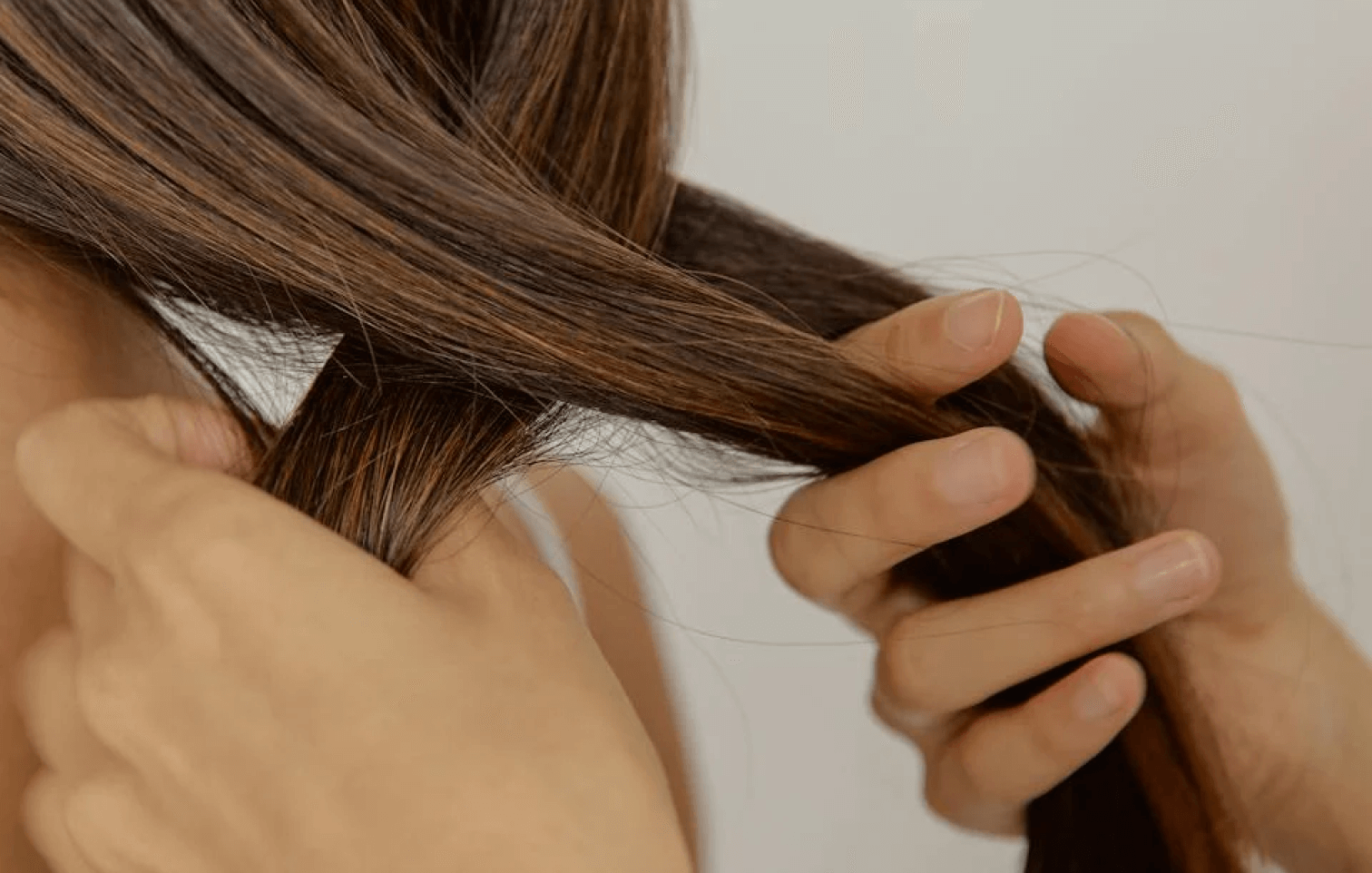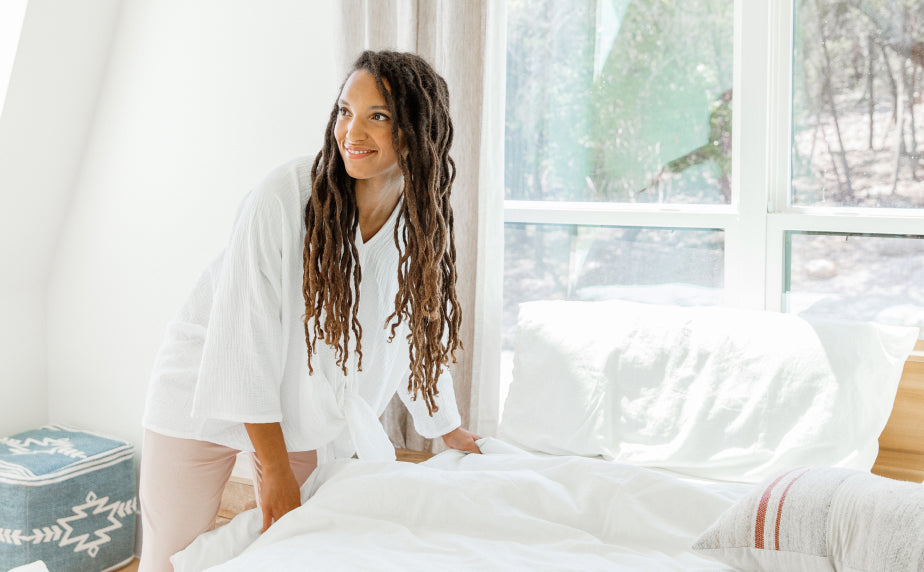Our Guide To Non-Toxic Hair Color + Salon Tips

If you've been looking for the best non-toxic hair color, this is the guide you've been searching for (woo hoo!).
As health-conscious moms, we know the struggle of trying to match your color with a non-toxic or low-tox brand that lasts, covers gray, works with your natural tones and highlights, and truly contains no (or very few) harmful chemicals.
It’s no wonder so many just give up and hope their healthy lifestyle will buffer the regular onslaught of chemicals.
Fortunately, thanks to new innovations in non-toxic hair color, you may not have to turn a blind eye to have fabulous hair.
While truly chemical-free hair colors are few and far between, our team has managed to find a few impressive products we’re comfortable recommending for all hair types.
In this article, we share our favorite non-toxic hair color brands, including pros and cons and where to buy them, plus helpful information on finding a low-tox hair salon.
(Note: This post does NOT contain affiliate links. Although we hope you'll explore our human-safe cleaning products, we want to provide unbiased recommendations and, therefore, do not profit from other brand recommendations in this article.)
Why Choose Low-Tox Or Non-Toxic Hair Color?
Hair color is arguably one of the most toxic beauty care products on the shelf.
This is largely because changing one's hair color requires a chemical reaction to open the hair follicle and infuse it with lasting color.
Then there are the dyes themselves (which also come from various chemicals), plus wetting agents, preservatives, fragrances to cover up the bad smell of the chemicals, and other ingredients, including [1] [2] [3]
- Cancer-causing PPD
- Formaldehyde
- Ethanolamines (also linked to cancer)
- Endocrine-disrupting phthalates
- Fragrance
- Ammonia
- Heavy metals
- Different forms of toluenes, which impact the nervous system
- And many more poisons and questionable ingredients
The bottom line is hair color requires chemistry (hence all the chemicals), but it can be achieved without toxic chemicals, which is great news for us!
Next, we share some of our favorite natural, low-tox, and non-toxic hair color brands to help you achieve beautiful color without compromise.
Non-Toxic Hair Color Pick #1: GREENHARE MUD
Greenhare Med is not a well-known brand, but a member of our team stumbled upon it while researching natural hair dyes…and she was pretty excited by the results.
According to founder Jeannie Wrightson, “Green Hare Mud is pure ground plant materials. We use zero fillers, binders, thickeners, preservatives, or anything in our product or packing that is not clearly listed.”
This product is not a hair “dye” per se because it contains “no lift".
Says Wrightson, “Lift is the chemical reaction required to actually change your hair’s color, and thus, it requires chemicals."
Rather, it’s a 100% natural permanent hair stain made of a proprietary blend of all-natural herbs, barks, berries, teas, and other ingredients that will permanently stain your hair and cover gray.
Jeannie shared with us about how the product came to be:
“Green Hare Mud was created by researching the ancient fiber dying recipes and processes of the spinners guilds. Working on the science that human hair is very similar to all other animal hair—like wool, angora rabbit hair, and alpaca fleece—the plants were then selected for suitability for the product, the process was refined to be user-friendly, and the seven current shades of Green Hare Mud were introduced.”
According to our in-house source, the application is very easy, and the results—in color, gray coverage, and durability—are worth the 30-90 minutes of processing time.
Another thing we love is that it contains virtually no plastic packaging, so there’s very little waste.
The only downside is their color palette is somewhat limited, but they cover all the bases (blonde, dark blonde, red, dark brown, very dark brown, etc.), and you can mix and match them to create a custom stain.
There’s even a “red remedy” if your hair tends to grab too much red from color.
Pros of Greenhare Mud:
- It's affordable
- Great gray coverage
- Nice selection of colors
- It takes less time than Henna
- Easy to mix and apply at home
- Most colors only require one application
- 100% plant-based, no harsh chemicals
- Very low waste
- You can shampoo after application
- No drying (in our experience)
Cons of Greenhare Mud:
- It requires at least 30 minutes of processing time, and possibly more if you have stubborn grays or very thick hair (heat speeds up the processing time).
- Contains henna, so some colors may be on the red side.
- May require a second application of a drabber if your hair picks up too much red.
- You may need to play around with the colors to get your perfect shade.
- Black or very dark brown hair requires a two-step process.
- It will not lighten hair.
- It can be messy to apply at first, but you'll quickly get the hang of it.
Tips for Using Greenhare Mud:
- Detoxifying your hair before applying at least once or twice a week with a chelating shampoo or by mixing baking soda into your favorite non-toxic shampoo.
- Get the consistency right! It should be like pancake batter or a a little thicker to avoid dripping.
- Don't worry about the color of the mixture. It may be green and/or strange-looking, but that won't be the final result.
- Use cotton cording as recommended to stop drips and protect your face.
- Apply heat to speed up the time. A small investment in a heated flaxseed cap or bonnet hair dryer will speed up the process significantly and enhance results.
- Check your roots before rinsing it out. Stubborn grays may require more processing time.
- Don't be afraid to mix colors to get your desired results.
Overall, we love Greenhare Mud and highly recommend it as an effective and affordable 100% natural plant-based hair color.
Learn more at: www.greenhare.com, check out their Facebook page for testimonials, and YouTube for tutorials.
Non-Toxic Hair Color Pick #2: HAIRPRINT
Hairprint is a popular option among health influencers, and the brunette and dark-haired members of our team love it, too.
Unlike conventional hair color or low/non-toxic alternatives, Hairprint is not a dye or stain.
It's a patented repigmentation product that returns hair to its original color without dyes, chemicals, or harsh toxins.
It uses only 8 food-grade ingredients, claims to cause no damage to hair, and boasts the “Made Safe” certification…which we know from experience, is pretty hard to get.
It’s been featured in several beauty publications, including Glamour and Goop, and has a loyal following.
Like the other non-toxic hair color options mentioned here, Hairprint has it's pros and cons.
Pros of Hairprint
- It works great on brown, brunette, or black hair, ideally with less than 50% gray.
- It doesn't contain Henna, so no problems with too much red.
- It contains no toxic ingredients.
- There is no strong smell, like with some Henna or herbal products.
- Those with more than 50% gray can purchase Hairprint+, which may work great (it did for members of our team).
- The color lasts as long as conventional hair color.
- You may be able to find a salon to apply it.
- The instructions are well communicated, and there are plenty of online tutorials and help available.
-
Great customer service. They have hair stylists available to help with questions and troubleshooting.
Cons of Hairprint
- It can be messy to apply, and you must apply it fairly quickly.
- Requires several applications and rinses to complete a single coloring. This takes time and effort, especially if you have more than 50% gray and/or coarse or very thick hair.
- The mixture can be irritating to sensitive skin (so be sure to apply oil or cotton cording around the hairline, ears, and neck to protect your face).
- It's more expensive than other options.
- There is more waste than other options.
- It will not work on blonde or red hair.
- It may not work on white hair.
- It may not work for those with more than 50% gray (although we received excellent feedback about Hairprint + for fine and medium-thick hair with more than 50% gray).
Tips for Applying Hairprint
- Detoxify your hair the week before per Hairprint instructions.
- Give yourself plenty of time. This can take up to two hours, especially if using Hairprint +.
- Watch video tutorials before applying to ensure you understand the process.
- The application can be messy (especially if you're new to this), so be sure to wear an old t-shirt and pants you don't mind staining and have plenty of old towels available and rags for wiping off counters, floors, etc.
- Apply a protective oil, such as amla or coconut oil, around the hairline, ears, neck, and chest to protect your skin and make wiping off any drips easy.
- Read instructions thoroughly and watch video tutorials before applying.
- If your hair ends up darker than usual, don't panic! It will lighten up after a couple of washes.
Based on the ingredients, their Made Safe certification, and the results Hairprint is an excellent non-toxic hair color option for all you brunette beauties out there.
Check out the ingredients and learn more here.
Non-Toxic Hair Color Pick #3: PURE HENNA PRODUCTS, LIKE MOROCCAN METHOD
Henna’s been around forever and is a tried and true, non-toxic, semi-permanent option.
It won’t damage your hair, and real Henna contains no harmful ingredients.
However, some Henna is made using heavy metals or is tainted with heavy metals, so knowing what you're getting is essential.
One of the most popular Henna products among the health-conscious crowd is Moroccan Method, which provides Henna and other pure plant products for all hair types and colors, including gray coverage.
Here's a quote from their site regarding purity and standards:
"Our henna hair dyes are beyond organic – they are wildcrafted and come from the same ten-acre farmstead in India where master henna farmers have been sustainably cultivating indigo, cassia, and amla henna varieties for generations. The same families who grow our all-natural hair dyes also grind the plants into fine henna leaf powder and package them for shipment. The final product is the safest henna on the planet: single-source, pure leaf, and chemical-free."
One myth about Henna is that it will turn your hair bright red.
Although pure Henna will do this, Henna mixes, if properly created, will not turn your hair bright red, provided you select the right color and follow instructions.
For example, Moroccan Method has Henna blends for blonde, light brown, medium brown, black, and others, including instructions on how to add Amla to cool down red tones.
Here, we share the pros and cons of Morroccan Method Henna (which will be similar for other pure Henna brands).
Pros of Morroccan Method Henna
- 100% plant-based and synthetic chemical-free.
- Affordable.
- Low-waste.
- Easy to apply (most colors only take one application).
- You can apply it to dry, clean hair (no cold, wet head required!).
- They provide instructions for adding additional ingredients, like herbs, teas, and apple cider vinegar or lemon juice, to reduce the natural Henna scent and deepen the color.
- Amla and other herbs are available to tone down red.
- Excellent written and online tutorials.
- Excellent gray coverage (although this may take more than one application).
- Variety of colors for every hair type.
- Gentle on hair and skin.
- Long-lasting color. One color application can last 8-10 weeks, depending on hair growth.
Cons of Morroccan Method (or any Henna)
- After mixing the color (which is easy), you must wait 8-10 hours before adding the additional herbs and applying the mixture. At that point, you must apply the mixture right away, so proper timing is essential.
- It takes a long time to process, 1-4 hours, depending on your hair type and desired color.
- The true color takes 72 hours to reveal itself, so you won't know the final results immediately.
- Black hair requires a two-step process for the indigo to stick to it; each step can take 1-4 hours.
-
They also recommend a two-step coloring process for covering gray hair (3 steps for black hair), which requires a 72-hour stint of living with bright red hair before you can apply the desired color.
- Note: Some people have had success using just a one-step process for gray and leaving the color on longer (3-4 hours), but you'll have to experiment. This can result in two-toned hair color, with the grays turning more blonde and the rest of the color being more brown.
- See recommended instructions for gray hair here.
- You cannot shampoo for 24 hours after application, so rinsing out the mixture can be cumbersome. However, you can apply their cream rinse to make this process easier.
- Your hair will smell like Henna for a few days, which we don't mind. It's kind of like a spinach herby smell.
Tips for Applying Henna
- Time it right! Morrocan Method, and other brands, require the mixed henna to sit in a bowl for 8-12 hours before applying and/or mixing in other ingredients.
- Get the texture right. Better too thick than too thin (dripping is not fun, especially if you're leaving it on for 1-4 hours).
- Get a good shower cap. Either plastic wrap or a shower cap will keep the henna moist and warm. We like a nice, tight-fitting cap to catch drips and for comfort.
- A flaxseed bonnet you can gently heat up is nice, too, but not required.
- Add the recommended herbs to tone down the scent (you'll be glad you did!), but do a patch test first to ensure they won't irritate your skin. Cinnamon, for example, can cause contact allergy in some people.
- Don't shampoo for 24 hours! We know it's tempting, but this will thwart your efforts! Some brands recommend a longer wait time, and we recommend following their advice.
Another misconception about Henna is that once you use it you can’t apply any other hair color until it grows out or you get it stripped out.
The truth is you can dye your hair with regular color after the Henna has faded for 2-3 weeks, but check with your stylist for their recommendations.
Using henna products, like the Moroccan Method, can take extra time and effort to master, but the clean, chemical-free results are well worth it!
Low-Tox Hair Color Pick #4: ALL-NUTRIENT
All-Nutrient is an organic hair coloring line I’ve (Allison) used with great success for several months.
Their permanent hair dyes are free of:
- Sulfates
- Parabens
- Formaldehyde
- Phthalates
- Propylene glycol
- MEA
- DEA
- and other toxic fillers
However, this is not a 100% non-toxic, clean option, so we highly recommend weighing the pros and cons of using hair dyes before jumping in!
For instance, during the years of healing my endocrine system, normalizing my menstrual cycles, getting pregnant, and nursing my newborns, I chose to skip all hair dyes in an effort to heal and strengthen.
Only after my body was stronger did I decide to use hair dyes, and even then, I took precautions.
After researching many “non-toxic” brands, I settled on All-Nutrient because it seems to be the cleanest.
A Few Tips To Lessen Exposures At The Hair Salon
If you do decide to dye your hair using a low-tox/less toxic product like All Nutrient, consider these tips & recommendations:
- Going lighter is less toxic than going darker.
- Doing only partial highlights is much better than doing a full color.
- I recommend going to a salon that only uses non-toxic/cleaner lines like All-Nutrient and does not do perms, as these contain a lot of toxic VOCs that should be avoided.
- I try to book my appointments during less popular times (fewer products being used in the salon), and fortunately, I’ve found a place that is small and willing to open the windows/doors while I’m there.
- Sit outside while your hair is foiled and setting.
- Drinking a lot of green juice, grounding, dry brushing, and taking your own clean shampoo are other very powerful ways to combat the more toxic hair dye exposures.
Further Reading On Clean Beauty
Being healthy isn't just about feeling your best; you want to look your best, too (we get that!).
We hope this guide gives you a helpful starting point on your low-tox or non-toxic hair color journey.
Did we leave any excellent, non-toxic hair color brands out?
Let us know about your experience with natural hair color in the comments below.
And check out our other natural and non-toxic personal care recommendations:
- How To Navigate Personal Care Products: Ingredients To Avoid And Use
- Our Non-Toxic Makeup Recommendations
- Our Favorite Non-Toxic Personal Care Products
- Feminine Care 101
- Allison's Non-Toxic Skincare and Beauty Routine
Sources Mentioned In This Article:
Categories

Allison Evans
Allison has dedicated herself to helping others reap the benefits of clean living. She, along with her husband and two daughters left Houston for the country life as she heals from a recent mold exposure and diagnosis of chronic Lyme disease. Follow her story on our Instagram and read more about her Journey to Fertility.








